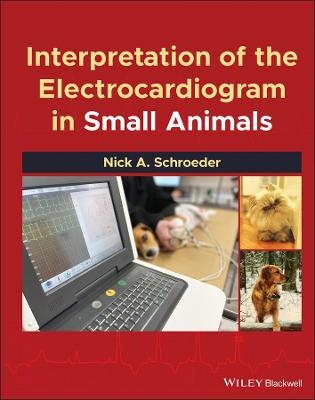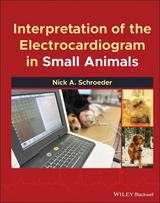Interpretation of the Electrocardiogram in Small Animals
»Interpretation of the Electrocardiogram in Small Animals« delivers a simplified and accessible approach to electrocardiography interpretation for veterinarians treating dogs and cats. This practical manual covers a comprehensive list of arrhythmias and associated phenomena using an easy-to-follow format, with hundreds of electrocardiograms and ladder diagrams supporting the text.
The book focuses on the clinical applications of electrocardiographic interpretation, with less emphasis on physics and subcellular mechanisms, making the book a useful patient-side resource. »Interpretation of the Electrocardiogram in Small Animals« offers readers an up-to-date understanding and knowledge of common and rare phenomena alike.
Beginning with a description of the single cardiac cycle as illustrated by surface EKG, the book moves on to describe variations on the P-QRS-T complex that occur in response to chamber enlargement and hypertrophy. Readers will also benefit from the inclusion of:
- A detailed discussion of aberrancy and its differentiation from ventricular ectopy
- A thorough exploration of arrhythmias and conduction disorders including escape mechanisms, atrioventricular block, extrasystoles, accelerated rhythms, tachycardias, flutter and fibrillation
- An examination of pacemaker basics, as well as a few common abnormalities and pacemaker problems, including undersensing, oversensing, and failure to capture
»Interpretation of the Electrocardiogram in Small Animals« is a convenient, one-stop reference for the interpretation of electrocardiography in small animals for veterinary students, residents, and specialists as well as for small animal general practitioners.
Nick A. Schroeder, DVM, DACVIM (Cardiology), is a staff cardiologist at LeadER Animal Special Hospital in Cooper City, Florida, USA.
Main Introduction
Part I: The P-QRS-T: Introduction
Chapter 1 The P-QRS-T: The Basics
Chapter 2 The P-QRS-T: Some Abnormalities
Chapter 3 The P-QRS-T: Trouble
Part II: Aberrancy: Introduction
Chapter 4 Atrial Aberrancy
Chapter 5 Right Bundle Branch Block
1) Left Bundle Branch Block
2) Fascicular Blocks
3) Wide Complex Supraventricular Tachycardia and Interventricular Conduction Disturbances
Part III: Arrhythmias: Introduction
Sinoatrial Arrhythmias: Introduction
4) Sinoatrial Bradyarrhythmias
5) Sinoatrial Block
6) Sick Sinus Syndrome
7) Sinoatrial Tachyarrhyhmias
Atrial Arrhythmias: Introduction
8) Atrial Bradyarrhythmias
9) Atrial Extrasystoles
10) Atrial Tachycardia
11) Bypass-Tract Mediated Supraventricular Tachycardia
12) Atrial Flutter
13) Atrial Fibrillation
Junctional Arrhythmias: Introduction
14) Junctional Bradyarrhythmias
15) Atrioventricular Block
16) Junctional Extrasystoles
17) Junctional Tachycardia
Ventricular Arrhythmias: Introduction
18) Ventricular Bradyarrhythmias
19) Ventricular Extrasystoles
20) Ventricular Tachycardia, Flutter and Fibrillation
Part IV: Pacemakers: Introduction
21) Pacemakers: The Basics
22) Pacemakers: Some Abnormalities
23) Pacemakers: Trouble
Individual Chapter Subsections:
Chapter 1 The P-QRS-T: The Basics
Leads
Waveforms/intervals
Amplitudes
Paper speeds
Mean electrical axis
False poling
Situs Inversus
Chapter 2 The P-QRS-T: Some Abnormalities
P pulmonale/right atrial abnormality
P pseudo-pulmonale
P mitrale/left atrial abnormality
Interratrial conduction defect
P pseudo-mitrale
P biatriale/biatrial abnormality
P pseudo-biatriale
Right ventricular hypertrophy/right axis deviation
Left ventricular hypertrophy/left axis deviation
Biventricular hypertrophy
Horizontal axis
Vertical axis
Indeterminant axis
Early repolarization
Chapter 3 The P-QRS-T: Trouble
P-R segment changes
Q-T segment changes
The prolonged QRS
Hyperkalemia
Hypokalemia
Other changes
calcium
magnesium
Q-Ti prolongation
hypothermia
Digoxin effects
Cushing's response
S-T segment elevation/depression
myocardial infarction/ischemic changes
Low-voltage QRS
Electrical alternans
Pericarditis
Chapter 4 Atrial Aberrancy
Interatrial/Intra-atrial block
Chung's phenomenon
Atrial ectopy
Chapter 5 Right Bundle Branch Block
Incomplete right bundle branch block
Ashman's phenomenon/2nd-in-a-row anomaly
Rate-dependent and intermittent right bundle branch block
Complete right bundle branch block
Chapter 6 Left Bundle Branch Block
Incomplete left bundle branch block
Rate-dependent and intermittent left bundle branch block
Complete left bundle branch block
Chapter 7 Fascicular Blocks
Left anterior fascicular block
Left medial fascicular block
Left posterior fascicular block
Bilateral bundle branch block
Bifascicular block
Masquerading bundle branch block
Trifascicular block
Arborization block
Chapter 8 Wide Complex Supraventricular Tachycardia and Interventricular Conduction Disturbances
Wide complex supraventricular tachycardia
Interventricular conduction disturbances
Chapter 9 Sinoatrial Bradyarrhythmias
Sinus bradycardia
Sinus arrhythmia
Non-phasic sinus arrhythmia
Phasic sinus arrhythmia
Respiratory sinus arrhythmia
Wandering pacemaker
Non-respiratory phasic sinus arrhythmia
Ventriculophasic sinus arrhythmia
Sinus bigeminy
Sinoatrial escape-capture bigeminy
Sinus pause
Sinus arrest
Asystole
Chapter 10 Sinoatrial Block
Type I 2nd degree sinoatrial block
Type II 2nd degree sinoatrial block
Chapter 11 Sick Sinus Syndrome
Overdrive suppression
Sinus nodal dysfunction
Bradycardia variant
Tachycardia-bradycardia variant
Chapter 12 Sinoatrial Tachyarrhythmias
Sinoatrial extrasystoles
Reciprocation
Parasystole
Sinus tachycardia
Sinus nodal reentrant tachycardia
Chapter 13 Atrial Bradyarrhythmias
Atrial escape beats
Atrial escape-capture bigeminy
Atrial escape rhythm
Atrial standstill
Hyperkalemia
Sinoventricular rhythm
Atrial muscular dystrophy
Chapter 14 Atrial Extrasystoles
Atrial premature complexes
Right atrial premature complexes
Left atrial premature complexes
Multifocal atrial premature complexes
Resetting
Resetting with a pause
Interpolation
Atrial bigeminy
Atrial trigeminy
Atrial premature complexes with aberrancy
Supernormal excitation
Non-conducted atrial premature complexes
Atrial fusion
Reciprocation
Parasystole
Chapter 15 Atrial Tachycardia
Accelerated atrial rhythm
Automatic atrial tachycardia
Interratrial reentrant tachycardia
Atrial dissociation
Chapter 16 Bypass-Tract Mediated Supraventricular Tachycardia
Ventricular pre-excitation and accessory pathways
Ventricular fusion
Atrial echo
Atrioventricular reentrant tachycardia
Orthodromic
Antidromic
Chapter 17 Atrial Flutter
Atrial flutter
Type I atrial flutter
typical
reverse typical/atypical
Type II atrial flutter ("true atypical")
Atrioventricular block
Artifacts
Chapter 18 Atrial fibrillation
Atrial fibrillation
Aberrancy
Ashman's phenomenon
Ventricular ectopics
Rule of bigeminy
Atrioventricular dissociation
Concealed conduction
Chapter 19 Junctional Bradyarrhythmias
Junctional escape beats
Junctional escape-capture bigeminy
Junctional escape rhythm
Rule of reset
Reciprocation
Junctional dissociation (double junctional rhythms)
Ventriculophasic junctional arrhythmia
Chapter 20 Atrioventricular Block
1st degree atrioventricular block (incomplete atrioventricular block with long P-Ri)
2nd degree atrioventricular block (incomplete atrioventricular block)
Type I 2nd degree atrioventricular block
Low grade
Typical Wenckebach periodicity
Atypical Wenckebach periodicity
2:1 Wenckebach
High grade
Type II 2nd degree atrioventricular block
Low grade
2:1 Mobitz
High grade
Block/acceleration dissociation
Paroxysmal atrioventricular block
3rd degree atrioventricular block (complete atrioventricular block)
Junctional escape
Ventricular escape
Atrioventricular dissociation
Ventriculoatrial block
Exit block
Chapter 21 Junctional Extrasystoles
Junctional premature complexes
Resetting
Resetting with a pause
Interpolation
Junctional bigeminy
Junctional trigeminy
Junctional premature complexes with aberrancy
Non-conducted junctional premature complexes
Concealed conduction
Atrial fusion
Reciprocation
Parasystole
Chapter 22 Junctional Tachycardia
Accelerated junctional rhythm
Isorhythmic dissociation
Accrochage
Synchrony
Automatic junctional tachycardia
Atrioventricular nodal reentrant tachycardia
Orthodromic
Antidromic
Chapter 23 Ventricular Bradyarrhythmias
Ventricular escape beats
Ventricular escape-capture bigeminy
Ventricular escape rhythm
Electromechanical dissociation
Asystole
Chapter 24 Ventricular Extrasystoles
Ventricular premature complexes
Right ventricular premature complexes
Left ventricular premature complexes
Compensatory pause
Compensatory-like pause
Interpolation
Post-extrasystolic aberrancy
Ventricular bigeminy
The Rule of bigeminy
Ventricular trigeminy
Ventricular quadrigeminy and pentageminy
Concealed conduction ("non-conducted ventricular premature complexes")
Concealed ventricular bigeminy
Concealed ventricular trigeminy
Ventricular fusion
Ventriculoatrial conduction and reciprocation
Atrial fusion
Parasystole
Chapter 25 Ventricular Tachycardia, Flutter and Fibrillation
Accelerated idioventricular rhythm
Atrioventricular dissociation
Isorhythmic dissociation
Accrochage
Synchrony
Ventriculoatrial association and accelerated ventricular rhythm
Polymorphic and bidirectional accelerated idioventricular rhythm
Ventricular tachycardia
Left ventricular tachycardia
Fascicular ventricular tachycardia
Bidirectional ventricular tachycardia
Right ventricular tachycardia
Right ventricular outflow tract tachycardia
Bundle branch reentrant ventricular tachycardia
Ventriculoatrial block
Double tachycardia
Polymorphic ventricular tachycardia
Torsades de pointes
Ventricular flutter
Ventricular fibrillo-flutter/ventricular dissociation
Ventricular fibrillation
Chapter 26 Pacemakers: The Basics
Indications
Unipolar vs. bipolar
Modes
Endocardial/transvenous vs. epicardial leads
MEA of the paced QRS
Chapter 27 Pacemakers: Some Abnormalities
Concealed conduction
VA conduction
Paced fusion complexes
Paced pseudofusion complexes
Paced reciprocal complexes
Chapter 28 Pacemakers: Trouble
Undersensing
Oversensing
Failure to capture
Battery depletion
Pacemaker-mediated tachycardia
Pacemaker syndrome
| Erscheinungsdatum | 29.06.2021 |
|---|---|
| Verlagsort | Hoboken |
| Sprache | englisch |
| Maße | 211 x 295 mm |
| Gewicht | 1334 g |
| Themenwelt | Veterinärmedizin ► Kleintier ► Innere Medizin |
| Schlagworte | Elektrokardiogramm (EKG) • Elektrokardiographie (Veterinärmedizin) • Kardiologie (Veterinärmedizin) • Kleintiere; Veterinärmedizin |
| ISBN-10 | 1-119-76305-3 / 1119763053 |
| ISBN-13 | 978-1-119-76305-5 / 9781119763055 |
| Zustand | Neuware |
| Haben Sie eine Frage zum Produkt? |
aus dem Bereich




